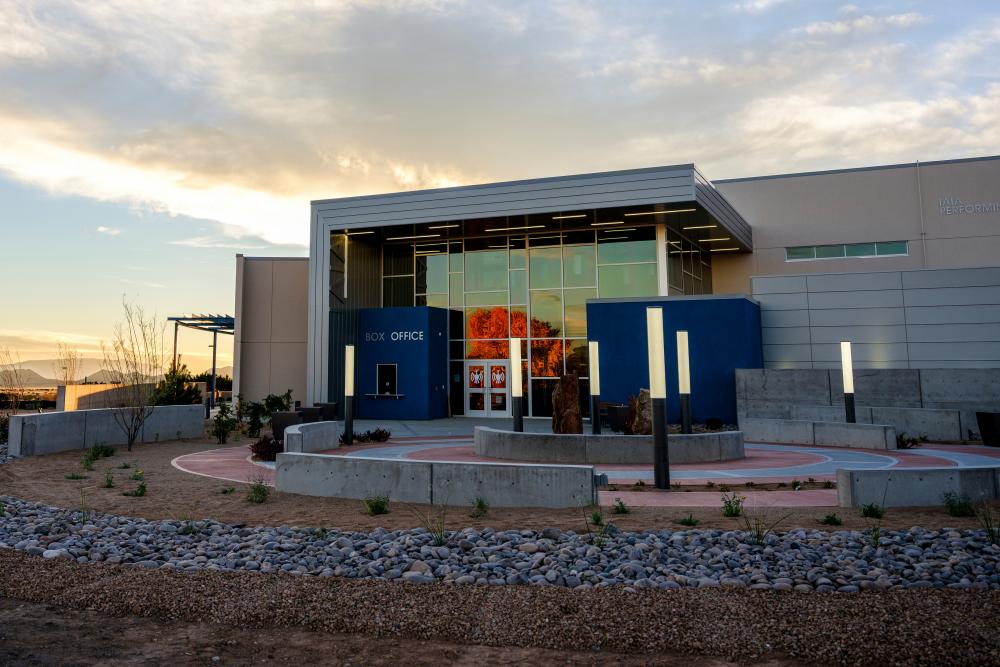While colleges and universities slow down during summer break, Ahniwake Rose is busy wondering what the fall semester will hold for the nation’s 37 tribal colleges and universities (TCUs) – and if they will be able to stay open much longer.
As the president and CEO of the Indigenous non-profit American Indian Higher Education Consortium (AIHEC), Rose (Cherokee and Muscogee Creek) braces as the schools she represents face a potential nearly 90% reduction in funding starting in October. President Donald Trump’s fiscal year 2026 budget includes a proposal to slash operations funding from $183.3m to $22.1m for Bureau of Indian Education post-secondary programs – career and technical schools, community colleges, four-year colleges and universities. On 15 July, a House appropriations subcommittee approved legislation that allotted $1.5bn to the Bureau of Indian Education, though it did not specify how much would go toward post-secondary programs. Congress still needs to finish approving the budget for the Bureau of Indian Education, a subdivision of the Department of Interior.
If approved, such cuts will further endanger a system that’s already undernourished. Congress currently underfunds the nation’s 37 tribal colleges and universities by $250m a year, according to a 2024 ProPublica report.
TCUs are heavily reliant on federal funding, which accounts for about 75% of their revenue. Those monies cannot be replaced with endowments or alumni donations as other higher education institutions do due to low wealth in Indigenous communities, said Rose. “There is really no other option, if not to close,” she said, “than to severely reduce the way that our institutions are able to provide services to our students.” Rose added that “there is not one TCU that would be able to walk away unscathed”.
While they are on summer recess, faculty and students have expressed concerns about their academic future as they fear that their schools will close next year.
“The impact that this is having on the morale of our community and our students has been deeply troubling,” Rose said. Some students are reconsidering whether they will begin school or continue their coursework next year. “Would the staff want to sign a contract for an institution that might not be able to pay them next year or in a few months?”
In anticipation of potential budget cuts, some schools have adjusted by canceling internships, fellowships and workforce study, said Rose. AIHEC is working with institutions to guarantee that the cancellations don’t affect students’ abilities to meet degree requirements and graduate. For students who relied on fellowships to support their education, the non-profit is partnering with the American Indian College Fund so that they can complete their education on time.
When Institute of American Indian Arts (IAIA) student Breana Brave Heart (Oglala Lakota Sioux and Northern Cheyenne) learned that the Trump administration was seeking to eliminate her school’s funding, she saw it as a betrayal. “It felt like a direct attack on us as Native students – on our dreams, our cultures and our treaty rights,” Brave Heart said in a statement to the Guardian. “IAIA isn’t just a college; it’s a promise our ancestors secured for us through sacrifice and agreements with the US government.”
Rose said that Brave Heart’s school was most vulnerable to a potential closure, since Trump’s 2026 discretionary budget request includes a plan to specifically eliminate funding for the school – without explanation. The four-year fine arts school that focuses on Alaska Native and Native American arts receives $13.5m in annual appropriations. That amount would be reduced to zero if the budget is approved by Congress.
“If they were to defund us,” the IAIA president, Robert Martin, (Cherokee) said, “then what would happen to those 850 students? Where would they go at this point?” Native Americans make up 80% of the student population, with 92 federally recognized tribes represented at the school.
Founded in 1962, IAIA has had an indelible influence on Indigenous arts, Martin said. Some of the most well-known alumni include the former US poet laureate Joy Harjo (Muscogee/Creek) and author Tommy Orange (Cheyenne and Arapaho of Oklahoma), a finalist for the Pulitzer prize for fiction.
“With the pandemic and historical trauma to begin with, there’s always been mental health issues [for students], and this adds a little bit more stress to being a college student,” Martin said. “In terms of faculty and staff, they are stressed about their employment outlook in the future, and what that’s going to bring.”
In the meantime, Martin is telling staff and students to expect to return to campus in the fall. School leadership has held town hall meetings for faculty and staff to allay their concerns, and they are preparing to increase their fundraising efforts.
An obligation to educate
Martin and Christopher Caldwell (Menominee), president at College of Menominee Nation in Wisconsin, hope that whenever a new budget passes, it will uphold the federal government’s promise to fund Indigenous education. The 1978 Tribally Controlled Colleges and Universities Assistance Act and about 150 treaties guaranteed federal funding to higher education, at a base amount of $8,000 per student adjusted for inflation.
Since June, school leaders and their allies have lobbied congressional members to continue supporting TCUs so they remain open in the upcoming academic year. Continued funding of the schools, which provides economic vitality to the entire community also allows tribes to govern themselves, said Rose.
“Our tribal colleges are a deep expression of self-determination and sovereignty. These education systems were created to support and build tribal leadership, to create education systems in which Native students can thrive and can build our economies,” Rose said. “Not only are the proposed cuts a direct attack against the trust and treaty responsibility that the federal government has to postsecondary institutions, it inhibits tribes’ ability to direct self-determination in our own education systems.” She added that her organization and the institutions were connecting with the current administration to underscore just how critical Department of Interior funding is to tribal colleges.
The Institute of American Indian Arts has been in contact with New Mexico’s congressional delegation and members of the appropriations committee to ensure that they understand the significance of funding for TCUs. “We’ve had bipartisan support for our programs, and it’s all part of the trust responsibility of the federal government,” Martin said. “Our ancestors ceded millions of acres of land to the federal government in return for certain promises, and one of those was education.”
Martin continued: “What we’re hearing from our donors and supporters is: ‘How can we help? And what can we do?’ We’re telling them to reach out to the congressional delegation immediately. But we also have to emphasize that we may have to experience some reduction in our funding, so we’re going to have to make that up in some way to continue to offer the quality of programs and really focus on student success.”
Students are also part of the campaign to preserve tribal education. Brave Heart, the IAIA student, is working with her peers to reach out to Congress. “We deserve more than to see our futures reduced to a line item crossed out in a budget. We need our elected leaders to honor their commitments to Indigenous students and uphold these sacred obligations.”
The potential closures of schools will greatly affect tribal economies, particularly since TCUs are sometimes the largest employers in their locales, said Rose. The non-profit plans to release an analysis that looks at the overall economic impact of TCUs on the surrounding communities around the nation.
Along with writing letters to congressional members, AIHEC is also helping the schools review their budgets and identify ways that they can cut costs. But for some institutions, the decreases are so steep it’s hard to plan.
Caldwell, the College of Menominee Nation president, said that the school’s federal funding would be reduced from $1.5m to $181,000 if Congress passes the proposed budget.
“How do you budget for the coming years when you see that kind of uncertainty?” Caldwell said. “We’re constantly weighing how much of these costs we are able to cover if the government suddenly stops paying their side of what they agreed to.”
The school is refiguring their strategic plan for the upcoming academic year and examining whether their academic offerings align with workforce trends.
In light of the financial hits that TCUs have faced since Trump entered office in January, including staff reductions at the Bureau of Indian Education, Caldwell said that the College of Menominee Nation had seen an increase in anonymous donations. “It demonstrated that there are people who support the work that we do in tribal nations and surrounding communities.”

